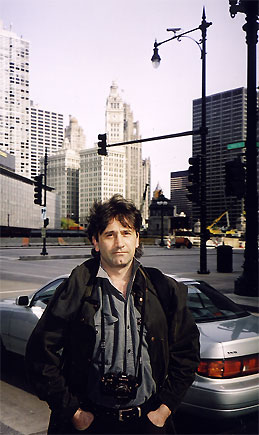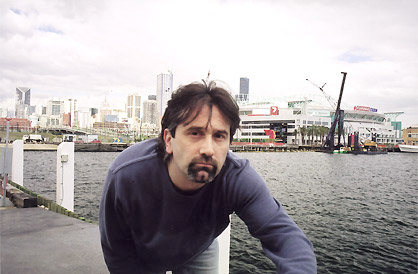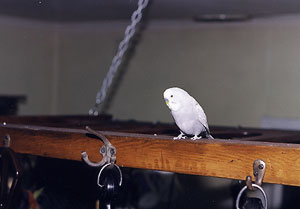Demetrios
Vakras was born in Melbourne, Australia, in 1962. He has been painting
with oil paints since 1977 and has never wavered from his elucidation of
the bizarre, fantastic and surreal. He is self-taught and his earliest
influence was the work of the surrealists: Dali, Magritte, Bellmer.
Vakras' current
imagery of dismembered human forms recombined with animal skulls, jaw and
pelvic bones, stem from his earlier so-called apocalypse series. In these
earlier paintings the individual is imprisoned by, and part of, the machinery
purpose-created to ease existence, machinery which for the term of an individual's
existence requires constant maintenance against its dissolution by entropy.
In his current
works the philosophical line has been largely abandoned. Although the pictorial
elements remain the same they generally serve no purpose other than the
fantastic. Forms metamorphose into unlikely recombinations. He sees veristic
illusionist fantastic art as an ongoing theme in western art which includes
within its historical repertoire Hieronymous Bosch, Grunewald, Blake, Fuseli,
the symbolists, the surrealists, the artists of the Vienna School of Fantastic
Realism,...etc.
Illusionist
fantastic art predates surrealism. Surrealism is now part of the inheritance
of fantastic art to come.
ARTIST STATEMENT:
Although
my early art was influenced by the surrealists it has continued to diverge
from traditional surrealist principles. I reject the idea that random accidents
make for good art (essentially Lautreamont's famed encounter of an umbrella
with a sewing machine on an operating table). Unless these accidents are
refined and articulated they remain accidents. This therefore takes my
work out of the surrealist ambit. My art is closer to what is called fantastic
art rather than surrealist. I suspect it would be best described as being
closer to a form of 19th century symbolism which however has learnt the
lessons of 20th century surrealism - a kind of "surrealised symbolism".
 |
"Man (or
woman) it's cold!!"
Demetrios grimacing
on a late Chicago morning as the temperature hovers at around 3 degrees
Celcius (or 38 F), with the wind making it all that much colder, 27 October
2002.
It only gets
this cold in Melbourne sometimes, in the middle of winter, in the dead
of night!!
But what would
the point be of visting anywhere if it was the same as home!
(Demetrios
was in Chicago to attend the opening of Echo Gallery's Halloween
Exhibition 2002 in which some of his works were featured, along with
works by Dan Ouellette, ----, and many others.)
|
POLEMICS:
Surrealism
in Australia tends to be disparaged. Criticism generally dismisses it with
contempt. Take as an example this excerpt from a review in the Sydney
Morning Herald 23/10/1993 by Age art critic Robert Nelson: "It must
be the year of the surrealist Phoenix...I hope it does not sow a generation
of unconscious painters."
I have
never known of the unconscious to paint....! This was supposed to be a
review on a monograph on Australian surrealist artist James Gleeson...instead
it was a personal attack on the artist because, as the critic made obvious,
he despises the genre.
...This
predisposition to stilted criticism is not limited to any one "art reviewer".
Other critiques demonstrate just as emphatically the shortcomings of the
intellect behind the critique. For instance the reviews by the Australian's
art critic, Robert Rooney (again on Gleeson's work*), made constant references
to science fiction:
" while
some of his images might seem to be Alien-like, he is not an illustrator
in the science-fiction or related genres." (W.E. Aust. 24-25/9/1994)
...
which sounds much like what he had written 3 years earlier: "I heard them
dismissed as being too much like science fiction illustration"(W.E.Aust.
26-27/10/1991).
Even
in reviewing another surrealist artist's work, in this instance the work
of EM Christensen, Rooney wrote: " the science fiction illustrations her
paintings sometimes resemble." .(W.E.Aust. 19-20/8/1989)... Either
Rooney attends such exhibitions (in 1989, 1991, 1994) with (coincidentally)
the same people or those that he "heard" dismissing the art as science
fiction are an invention. I have been to several Gleeson exhibitions and
never heard any such comments.
It
is worth remarking that:
A/
Gleeson's repertoire was already established with paintings like Citadel
(1945) and Agony in the Garden 1 (1947) - which makes a 5 and then
7 year old Giger (born 1940) an unlikely influence!
B/
Both Rooney (a practicing "artist") and Gleeson were represented by the
Melbourne gallery Pinacotheca... One suspects Rooney felt compelled to
review the works by another artist practising a genre he was obviously
largely ignorant of, so that he could promote the profile of the gallery
which represented him....
By
describing as "science fiction" or alluding to its appearance as "science
fiction" any art of the imagination is reduced to low brow populist illustration
- ephemera. I suspect the fear is that great art is elitist - that is,
very few have the talent to produce it. Most post-Duchamp garbage is "egalitarian"
- anyone can be an artist by labelling anything art and simply calling
themselves an "artist". "Art" then is expression unencumbered by technique,
ability, or even the need to say anything at all..... It is all about pretensions
to grandeur.
*note:
James Gleeson is pretty much the only artist of the imagination whose work
is reviewed by the mainstream Australian media and is Australia's only
"successful" artist of the genre. Hence reviews on him are plentiful.
An aspect
of art appraisal that fascinates me is the categorisation of any work by
an unfamiliar artist as being similar to, influenced by, or in imitation
of, the style of another. In days past the only surrealist artist popularly
known in Australia was Dali. Consequently my work was "like Dali's"! Now
I'm apparently just like Giger*!(* mispronounced by anglophones as "Geiger"!)And
this is not limited to the general public's perception of art...As a case
in point, Robert Hughes (former art critic for Time magazine), in
his book titled The Art of Australia, 1966, dismisses the work of
James Gleeson (again) as nothing more than the work of a Dali imitator:
"James Gleeson worked closest to the accepted idea of surrealism - that
is to say, he imitated Dali so closely that he became a pasticheur." Gleeson
is nothing like Dali. He is the only Australian artist who instead of being
constrained by the Australian landscape used it to create a world unlike
any other created by any surrealist.... Gleeson's error, it would appear,
is that he did not illustrate Australian folk-tales....
...AUSTRALIANA.........
This is the
great tragedy of Australian art: it is the artists who pander to the national
psyche... and illustrate national folklore and myths that are the ones
acclaimed and celebrated. Art, like sports, must serve the national interest
to succeed.... Essentially it is national propaganda art....like that of
the Boyds et al, which is therefore celebrated.
....... As
Jeffrey Makin, art critic of the Herald Sun recently wrote in his
obituary on Arthur Boyd:
"Boyd, more
than any other Australian painter peopled our outback with accessible motifs
that helped form our national psyche and self image...he will be sorely
missed." (Herald Sun 28 April 1999)
So "Australian"
was Boyd that he lived in London....not Australia when he died...
This is, I
suppose, symptomatic of a nation with no identity which, in endeavouring
to create an identity, celebrates populist and mindnumbingly obvious ho-hum
symbols.
My view is
hardly unsupported:
"The late 1940s
and on into the 1950s saw the perennial testing by Australian artists of
themselves on the European [British] scene...Drysdale and Nolan (and subsequently
Arthur Boyd) in particular were exhibiting their Australian imagery and
achievement on the international stage and, for better or for worse, not
without success. For others, not so stridently identifiable in their Australianness,
this was not always the case."p. 219 A Story of Australian Painting.
Mary Eagle & John Jones, Macmillan Australia.
Gleeson's
work was never "Australian" enough...his paintings sell for around thirty
thousand Australian dollars. The very "Australian" Boyd, however, sold
his works for well over five HUNDRED thousand Australian dollars...Ironically
Boyd's works are worthless internationally.
On
21 June 2000 the Prime Minister of Australia, John Howard, made a speech
at an Australia Council opening. He quoted from a report which studied
how to best promote the arts in Australia. The following is part of the
transcript:
"...the report
found [that] the great majority of Australians saw the Arts as an opportunity
to express...what we think it is to be Australian, what the essence
of Australianism is and the values that we hold as Australians. And
that very strong identification between the Arts and our national identity
is always something that I believe has resonated very strongly in the Australian
community." (my italics)
The great
tragedy is, that realising that they are merely Englishmen (& women)
displaced , Australians have tended to try to create an identify separate
from England. The landscape then becomes an obvious motif as a point of
difference.
It is not coincidental
therefore that artists such as Nolan, Boyd, Drysdale, are ethnic English,
who went to their motherland at the conclusion of the second world war
where they were celebrated as greats simply because their Australian landscape
did not look English...and who upon their return were celebrated as greats
in Australia on the basis of this recognition in England. Australia has
always looked to the "superior" dictates of its ethnic motherland...
When given
the choice, Australians voted to keep the Queen of England as their own
head of state in the recent referendum of November 1999.
And if art
is merely the vehicle for expressing myopic parochial and nationalistic
visions then it is no different from the art of Stalinist Russia, Nazi
Germany, or the state sponsored art of Saddam Husein's Iraq.
At
this stage however, it is worth pointing out that the current trends in
Australian art are also dictated by art fashion. New York is almost as
influential as London once was. To be cultured is to be aware of the current
art fashion trend. And so, like the Pokemon phenomenon amongst their children,
the adult connoisseur, not to appear a moron amongst his/her peers, can
name all the Pokemon characters.... metaphorically speaking. And the last
thing you would want to do is discredit your well-earned reputation, by
praising the work of an unknown artist.
It does, however,
remain a prerequisite in Australian art that artists still somehow demonstrate
their "Australianness", as the crisis in identity is not an issue yet resolved
in this country.


